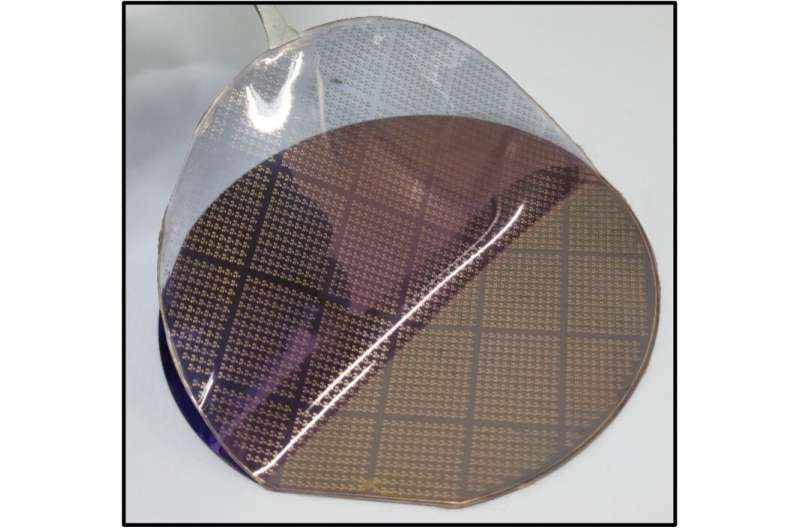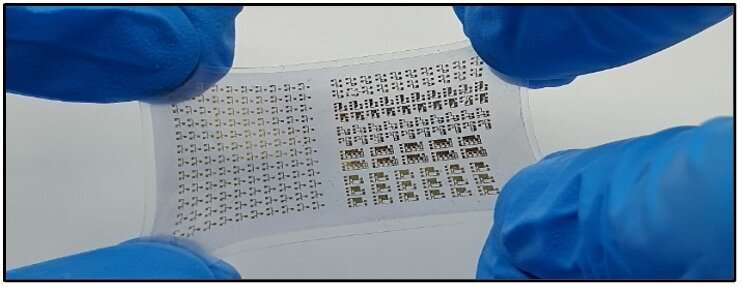
Over the past few years, material scientists and electronics engineers have been trying to fabricate new flexible inorganic materials to create stretchable and highly performing electronic devices. These devices can be based on different designs, such as rigid-island active cells with serpentine-shape/fractal interconnections, neutral mechanical planes or bunked structures.
Despite the significant advancements in the fabrication of stretchable materials, some challenges have proved difficult to overcome. For instance, materials with wavy or serpentine interconnect designs commonly have a limited area density and fabricating proposed stretchable materials is often both difficult and expensive. In addition, the stiffness of many existing stretchable materials does not match that of human skin tissue, making them uncomfortable on the skin and thus not ideal for creating wearable technologies.
Researchers at Sungkyunkwan University (SKKU), Institute for Basic Science (IBS), Seoul National University (SNU), and Korea Advanced Institute of Science and Technology (KAIST) have recently fabricated a vacuum-deposited elastic polymer for developing stretchable electronics. This material, introduced in Nature Electronics, could be used to create stretchy field-effect transistors (FETs), which are primary components of most electronic devices on the market today.
“Recently, various approaches for adopting soft materials have been proposed for developing intrinsically stretchable electronics which does not need any specific structural designs owing to their intrinsic deformability,” Donghee Son, one of the researchers who carried out the study, told Tech Xplore. “However, such devices employed solution-processed dielectric materials and thereby encounter critical challenges in achieving high electrical performances.”
Solution-processed organic gate dielectric materials, materials that can transmit electricity without conducting it (i.e., insulating it), are not particularly suitable for the creation of flexible electronics. Most notably, they have thicknesses in the micrometer-scale, poor insulating performances, chemical instability and a low uniformity. In addition, they are typically incompatible with conventional microfabrication processes, making them difficult to produce on a large scale.
As a result of these limitations, electronic components based on these solution-processed materials are plagued by poor gate controllability and high operation voltages, as well as a limited scalability. Son and his colleagues, along with other research teams worldwide, have thus been trying to create ultrathin, stretchable, scalable, and highly performing dielectrics with alternative fabrication strategies.
“In our study, we present a new approach to the design of dielectric materials to resolve the aforementioned challenges in intrinsically stretchable electronic devices,” Son explained. “Our large-scale vacuum-deposited stretchable dielectric enables the scalable fabrication of intrinsically stretchable devices with electrical performances comparable to those fabricated using the non-stretchable inorganic and stretchable organic dielectric materials (e.g., Al2O3 deposited via atomic layer deposition & spin-coated viscoelastic layer).”

To create their polymer-based dielectric, Son and his colleagues first copolymerized two different monomers, namely isononyl acrylate (INA) and 1,3,5-trimethyl-1,3,5-tryvinyl cyclotrisiloxane (V3D3) using a process known as initiated chemical vapor deposition (iCVD). The monomer INA acts as a soft segment, increasing the material’s stretchability, while V3D3 serves as a cross-linkable hard segment, giving the polymer film robust insulating properties.
“The mixing ratio of the monomers (INA and V3D3) was optimized to achieve both insulating and stretching performance of the device,” Son said. “Our vacuum-deposited polymer dielectric with dielectric constant of 3.59 and breakdown field of 2.3 MV/cm showed the equivalent oxide thickness (EOT) value of less than 200 nm, which is the lowest value among the stretchable dielectric layers reported to date.”
To demonstrate the promise of their material, the researchers used it to create transistors, and then used these to create stretchy inverters and logic gates. In initial tests, these components achieved very promising results.
In addition to a high dielectric constant and a low EOT value, they could be stretched up to a 40% strain, while retaining their insulating performance. The team also found that their material exhibits a high chemical and thermal stability during microfabrication processes and remains highly uniform over large areas.
“Ours is the first account of a vacuum-deposited stretchable dielectric, also demonstrating its application to intrinsically stretchable electronic devices,” Son said. “In other words, comparing conventional thick polymer dielectrics, a stretchable vacuum-deposited nanometer-thick film (approximately 160 nm) has exceptional electrical, mechanical, and chemical properties. The exceptional advantages that are inherent in our vacuum-deposited methodology could facilitate the development of high-performance wafer-scalable wearable devices. The observations of our study would transform the conventional paradigm of soft electronics.”
In the future, the team’s material could enable the fabrication of new intrinsically stretchable and highly performing transistors and logic circuits that consume less electrical power. These transistors and circuits could be used to create numerous soft electronics, including wearable and implantable devices.
“I think achieving an energy-efficient performance in stretchable electronic devices will be the most important issue in the long-term development of reliable wearables,” Son added. “Thus, thickness of the vacuum-deposited insulating materials should be increasingly thinner, to improve gate controllability while maintaining stretchability. Furthermore, its dielectric constant would be improved up to over 10, which is comparable to that of the high-k inorganic dielectric.”
More information:
Ja Hoon Koo et al, A vacuum-deposited polymer dielectric for wafer-scale stretchable electronics, Nature Electronics (2023). DOI: 10.1038/s41928-023-00918-y.
© 2023 Science X Network
Citation:
A new elastic polymer dielectric to create wafer-scale stretchable electronics (2023, February 17)
retrieved 17 February 2023
from https://techxplore.com/news/2023-02-elastic-polymer-dielectric-wafer-scale-stretchable.html
This document is subject to copyright. Apart from any fair dealing for the purpose of private study or research, no
part may be reproduced without the written permission. The content is provided for information purposes only.
Stay connected with us on social media platform for instant update click here to join our Twitter, & Facebook
We are now on Telegram. Click here to join our channel (@TechiUpdate) and stay updated with the latest Technology headlines.
For all the latest Technology News Click Here
For the latest news and updates, follow us on Google News.
